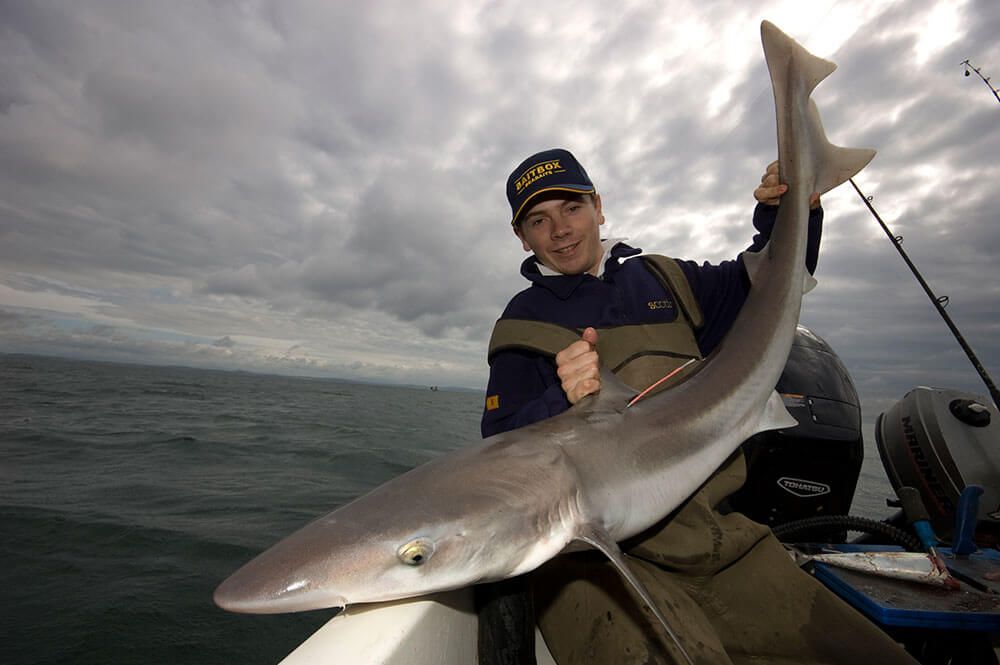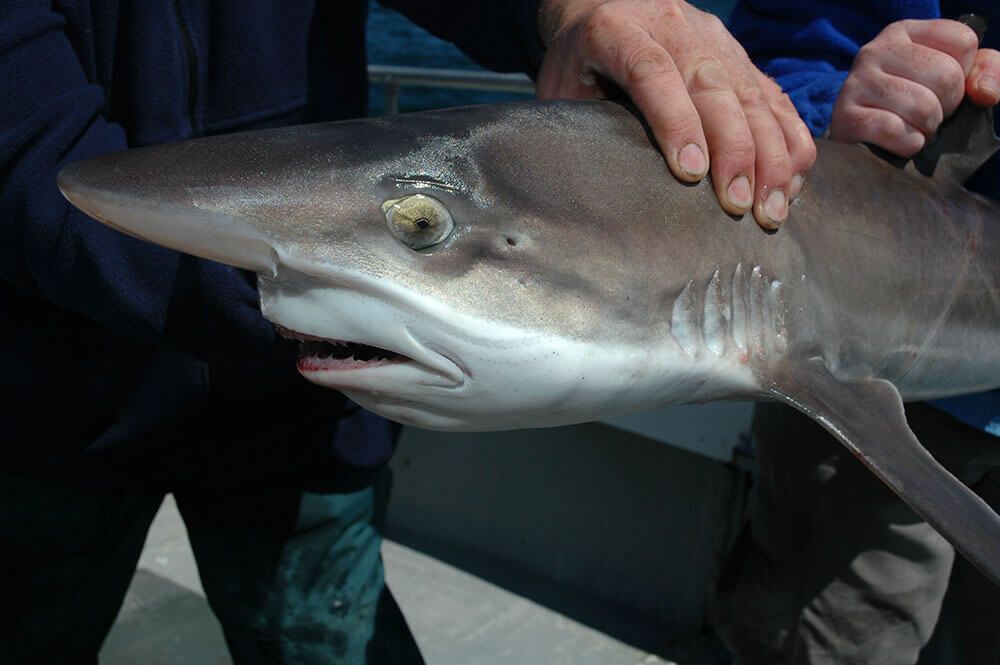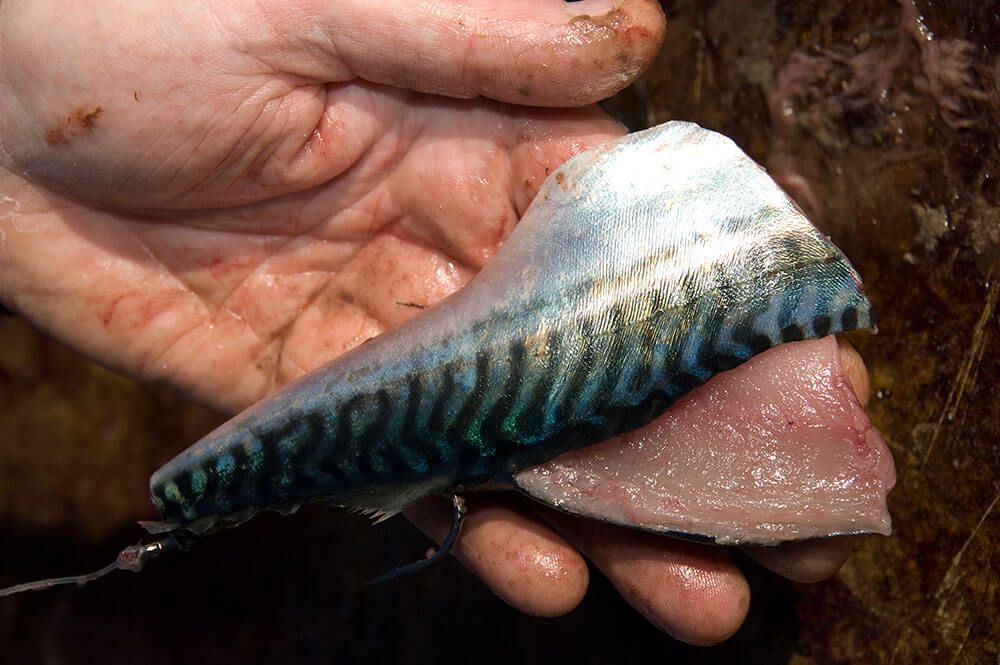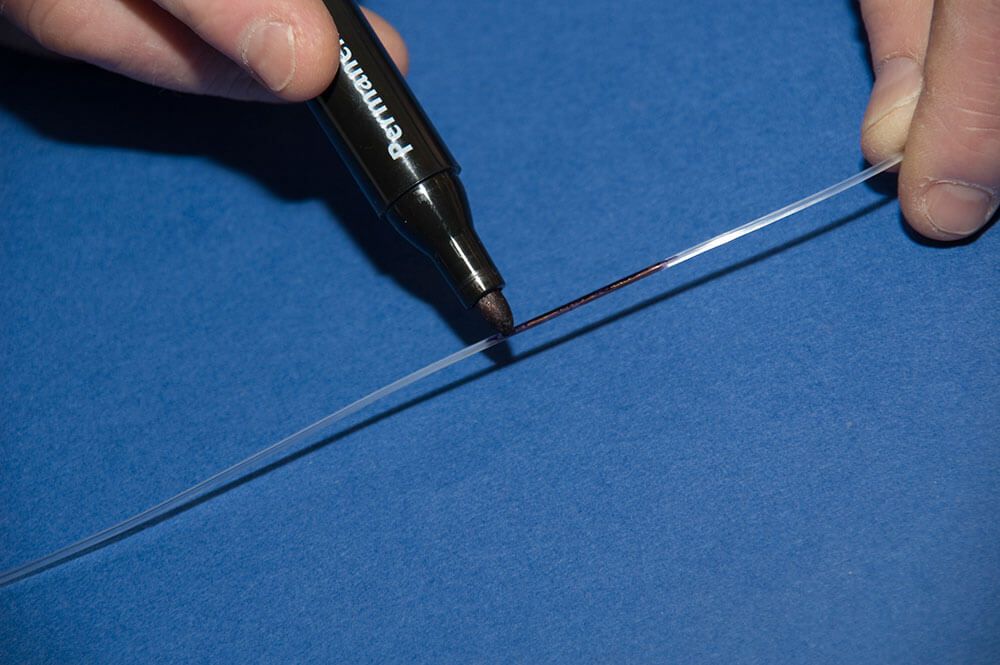Tope are relatively easy to identify. They can only really be confused with smoothound. The quick way to check between the two is the teeth. Tope have true shark’s teeth, triangulated, serrated and sharply pointed, perfect for grabbing and cutting live prey. The smoothhound has flat blunt teeth used for grinding crab and shellfish.
Also look at the pectoral fin. On the tope the pectoral fin is long, but on the smoothound short and more triangulated. Also look at the lower tail lobe of the tope, this again is longer and comes to a point, whereas on the smoothhound the lower tail lobe is just short and rounded.
A tope’s colouration is typically uniform grey with a white belly, but when living on sand the back will take on a fawny brown colour.
Tope have been recorded to over 120lb in weight commercially, but this is probably close to the maximum ceiling weight for the species in UK waters.
The breeding season is typically from mid April to mid July and takes place over sandbanks. Females give birth to live young some 15-inches in length. Litters of 20 to 40 pups are common but larger females can produce more. The pups are born in late summer, usually close to shore and adjacent to reef structure. It’s no coincidence that this birthing period coincides with the smaller pack tope migrating offshore saving the small pups from being eaten by their own kind.

Tope are typically shallow water fish found in depths down to 100-feet, but occasionally can be as deep as 600-feet.
Their diet consists of mainly bottom dwelling fish such as dabs, whiting, poor cod, pouting, small codling and gurnards, but on reef ground small black bream and bass is their main target. Contrary to popular belief mackerel do not form a major part of the tope’s diet. Fit mackerel can leave a fit tope way behind at the traffic lights, tope can usually only catch injured or weak mackerel.
WHEN AND WHERE TO FISH
Tope are found all round the UK and Ireland, though numbers are limited north of the Yorkshire coast up the Scottish east coast as far as the east side of Orkney. They are also found as far north as the southern coast of Norway, throughout the Mediterranean and down the North African coast.
Some of the best fishing is in The Wash off the Lincolnshire coast, in the Thames Estuary, off Swansea and Tenby in South Wales, especially Cardigan Bay in Mid Wales, off Blackpool and inside the Solway Firth. Ireland’s best tope fishing is off the east coast between Bray and Kilmore Quay, in the Shannon Estuary, and in the north in Lough Swilly. Big tope also come from Strangford and Carlingford Loughs in Northern Ireland.
The season for tope begins in late March with fish showing from the Welsh coast and from the Thames Estuary. By May they have moved north as far as The Wash and the Lancashire coast. By June they have crossed the water border into Scotland and can be caught in July and August as far north as The Orkney Islands. Tope can be caught late in to November but in southern areas they move offshore in late July leaving smaller pack tope which stay until August or so. Big fish linger later off the Cornish and Welsh coasts with odd fish showing in deeper water between November and February in mild winters.

Small tope up to 30lbs or so work in packs and are wide ranging depleting the food supply in one area and moving on to the next. Bigger fish over 40lbs will most likely be females and are often swimming alone, though in the period May to June can be found with the smaller male tope when breeding.
BOAT TACKLE
The days of 50lb class rods are long gone when tope fishing. Angler’s should now look at light 12/15lb class rods matched to smaller lightweight reels such as the Penn Fathom 20, ABU Alphamar 16’s and Shimano Torium’s loaded with 15lb/18lb mono when fishing shallower water. In deeper water a 20lb class rod and the same reels loaded with 20lb mono may be the better choice. Braid line is also good but not as popular when fishing for big fast running fish like tope, though in fast tidal areas it may be the only option to fish. If you choose braid tie on a clear mono leader at least twice the length of the rod to provide some elasticity when a fish is close to the boat.
In areas of fast tides and shallow water, such as the Thames estuary, casting baits away from the boat is very effective as it puts the baits out of the scare area created by the tide flowing past the hull of the boat. Most anglers choose a 9ft 6in to 10ft rod rated to cast 4/10ozs with reels such as the Penn 515 and 525Mag2’s, ABU 7000 series, and Daiwa Slosh’s popular. 15 to 20lb main reel line is a good option, though again some anglers choose braid for this as casting range is relatively short, under 50yds, and the thin diameter of the braid allows lighter leads to hold efficiently.
When targeting tope at the edges of very shallow reefs, you can also fish fixed spool reels. Those chosen are usually bait runner types with the Penn 560 Live Liner and Shimano Bait Runner reels top contenders. These allow you to cast baits with minimal or no lead weight to give natural presentation, especially during slack water periods. Having the bait runner option to give line freely, but re engage the reel by a simple turn of the handle is ideal for this style of fishing.
HOW TO BUILD A BOAT TOPE MONO RIG
HOW TO BUILD A BOAT TOPE WIRE RIG
TOPE BAITS
Although most anglers assume that mackerel, usually as a tail or head flapper with the backbone cut out, is the best tope bait, and it does catch well, but in reality there are more consistent baits. The best bait is half a small dab cut diagonally across the body and using the head and guts as the bait. Tope feed on dabs primarily and this is why it’s the top bait. Alternatively use half a whiting, head half again, whole small poor cod, pouting and even small pollack all of which can often out fish mackerel.

If you’re using cut fish baits, then half a small mackerel, half a bluey or a whole squid all make good alternative baits.
Most anglers make the mistake of using baits far too big. Although a shark species tope have relatively small mouths and will pick up then drop repeatedly baits that are too big. Baits no more than 6-inches long are ample.
TOP TIP 1
There is a difference of opinion over tope trace construction. Some anglers prefer to use heavy 150lb mono, as they feel it is friendlier to the fish. Others choose to use a short section of 50lb wire. The facts are that in deep water tope will pick up the heavy mono without problem, especially in a tide that unrolls the coils of stiff mono. It’s a different matter when fishing close to shallow reefs in gin clear water just 8-feet deep with no tide run. In these circumstances tope will either shy away from the mono, or pick up and instantly drop the bait. This is when wire is the better option.
TOP TIP 2
If a tope picks up and drops the bait, leave it there. The odds are that another tope is close behind and will take the same bait. Alternatively, if the bait is dropped, twitch the bait forward by retrieving a few feet of line to make the tope think an injured fish is trying to get away. This will result in an instant strike.
TOP TIP 3
When fishing over reef ground in clear, shallow water and choosing to fish with heavy mono hook traces, use a permanent black marker to colour the line. This will then camouflage itself amongst the rocks and avoid the tope being spooked.

TOP TIP 4
Too many anglers’ fish hook sizes far too big for tope and will miss fish as a consequence. Typically a strong Viking pattern size 6/0 is ample and is more than strong enough to land record fish. For bigger baits, then go no bigger than a Mustad Barbless Tope and Ray hook size 8/0. You can alternatively crimp the barb on a hook down with pliers. Having barbless hook will not cost you any lost fish providing you keep the line tight at all times.
TOP TIP 5
When tope fishing always set the reel in free spool with the ratchet alarm engaged. This allows the tope to run off with the bait but feel minimal resistance. Also set the drag to give line under steady pressure well below the lines breaking strain.
Do not strike the fish with the rod. Let the fish run a few yards of line off the reel then put the reel in gear and let the drag set the hook against the weight of the fish as the line comes tight.
Also look at the pectoral fin. On the tope the pectoral fin is long, but on the smoothound short and more triangulated. Also look at the lower tail lobe of the tope, this again is longer and comes to a point, whereas on the smoothhound the lower tail lobe is just short and rounded.
A tope’s colouration is typically uniform grey with a white belly, but when living on sand the back will take on a fawny brown colour.
Tope have been recorded to over 120lb in weight commercially, but this is probably close to the maximum ceiling weight for the species in UK waters.
The breeding season is typically from mid April to mid July and takes place over sandbanks. Females give birth to live young some 15-inches in length. Litters of 20 to 40 pups are common but larger females can produce more. The pups are born in late summer, usually close to shore and adjacent to reef structure. It’s no coincidence that this birthing period coincides with the smaller pack tope migrating offshore saving the small pups from being eaten by their own kind.

Tope are typically shallow water fish found in depths down to 100-feet, but occasionally can be as deep as 600-feet.
Their diet consists of mainly bottom dwelling fish such as dabs, whiting, poor cod, pouting, small codling and gurnards, but on reef ground small black bream and bass is their main target. Contrary to popular belief mackerel do not form a major part of the tope’s diet. Fit mackerel can leave a fit tope way behind at the traffic lights, tope can usually only catch injured or weak mackerel.
WHEN AND WHERE TO FISH
Tope are found all round the UK and Ireland, though numbers are limited north of the Yorkshire coast up the Scottish east coast as far as the east side of Orkney. They are also found as far north as the southern coast of Norway, throughout the Mediterranean and down the North African coast.
Some of the best fishing is in The Wash off the Lincolnshire coast, in the Thames Estuary, off Swansea and Tenby in South Wales, especially Cardigan Bay in Mid Wales, off Blackpool and inside the Solway Firth. Ireland’s best tope fishing is off the east coast between Bray and Kilmore Quay, in the Shannon Estuary, and in the north in Lough Swilly. Big tope also come from Strangford and Carlingford Loughs in Northern Ireland.
The season for tope begins in late March with fish showing from the Welsh coast and from the Thames Estuary. By May they have moved north as far as The Wash and the Lancashire coast. By June they have crossed the water border into Scotland and can be caught in July and August as far north as The Orkney Islands. Tope can be caught late in to November but in southern areas they move offshore in late July leaving smaller pack tope which stay until August or so. Big fish linger later off the Cornish and Welsh coasts with odd fish showing in deeper water between November and February in mild winters.

Small tope up to 30lbs or so work in packs and are wide ranging depleting the food supply in one area and moving on to the next. Bigger fish over 40lbs will most likely be females and are often swimming alone, though in the period May to June can be found with the smaller male tope when breeding.
BOAT TACKLE
The days of 50lb class rods are long gone when tope fishing. Angler’s should now look at light 12/15lb class rods matched to smaller lightweight reels such as the Penn Fathom 20, ABU Alphamar 16’s and Shimano Torium’s loaded with 15lb/18lb mono when fishing shallower water. In deeper water a 20lb class rod and the same reels loaded with 20lb mono may be the better choice. Braid line is also good but not as popular when fishing for big fast running fish like tope, though in fast tidal areas it may be the only option to fish. If you choose braid tie on a clear mono leader at least twice the length of the rod to provide some elasticity when a fish is close to the boat.
In areas of fast tides and shallow water, such as the Thames estuary, casting baits away from the boat is very effective as it puts the baits out of the scare area created by the tide flowing past the hull of the boat. Most anglers choose a 9ft 6in to 10ft rod rated to cast 4/10ozs with reels such as the Penn 515 and 525Mag2’s, ABU 7000 series, and Daiwa Slosh’s popular. 15 to 20lb main reel line is a good option, though again some anglers choose braid for this as casting range is relatively short, under 50yds, and the thin diameter of the braid allows lighter leads to hold efficiently.
When targeting tope at the edges of very shallow reefs, you can also fish fixed spool reels. Those chosen are usually bait runner types with the Penn 560 Live Liner and Shimano Bait Runner reels top contenders. These allow you to cast baits with minimal or no lead weight to give natural presentation, especially during slack water periods. Having the bait runner option to give line freely, but re engage the reel by a simple turn of the handle is ideal for this style of fishing.
HOW TO BUILD A BOAT TOPE MONO RIG
HOW TO BUILD A BOAT TOPE WIRE RIG
TOPE BAITS
Although most anglers assume that mackerel, usually as a tail or head flapper with the backbone cut out, is the best tope bait, and it does catch well, but in reality there are more consistent baits. The best bait is half a small dab cut diagonally across the body and using the head and guts as the bait. Tope feed on dabs primarily and this is why it’s the top bait. Alternatively use half a whiting, head half again, whole small poor cod, pouting and even small pollack all of which can often out fish mackerel.

If you’re using cut fish baits, then half a small mackerel, half a bluey or a whole squid all make good alternative baits.
Most anglers make the mistake of using baits far too big. Although a shark species tope have relatively small mouths and will pick up then drop repeatedly baits that are too big. Baits no more than 6-inches long are ample.
TOP TIP 1
There is a difference of opinion over tope trace construction. Some anglers prefer to use heavy 150lb mono, as they feel it is friendlier to the fish. Others choose to use a short section of 50lb wire. The facts are that in deep water tope will pick up the heavy mono without problem, especially in a tide that unrolls the coils of stiff mono. It’s a different matter when fishing close to shallow reefs in gin clear water just 8-feet deep with no tide run. In these circumstances tope will either shy away from the mono, or pick up and instantly drop the bait. This is when wire is the better option.
TOP TIP 2
If a tope picks up and drops the bait, leave it there. The odds are that another tope is close behind and will take the same bait. Alternatively, if the bait is dropped, twitch the bait forward by retrieving a few feet of line to make the tope think an injured fish is trying to get away. This will result in an instant strike.
TOP TIP 3
When fishing over reef ground in clear, shallow water and choosing to fish with heavy mono hook traces, use a permanent black marker to colour the line. This will then camouflage itself amongst the rocks and avoid the tope being spooked.

TOP TIP 4
Too many anglers’ fish hook sizes far too big for tope and will miss fish as a consequence. Typically a strong Viking pattern size 6/0 is ample and is more than strong enough to land record fish. For bigger baits, then go no bigger than a Mustad Barbless Tope and Ray hook size 8/0. You can alternatively crimp the barb on a hook down with pliers. Having barbless hook will not cost you any lost fish providing you keep the line tight at all times.
TOP TIP 5
When tope fishing always set the reel in free spool with the ratchet alarm engaged. This allows the tope to run off with the bait but feel minimal resistance. Also set the drag to give line under steady pressure well below the lines breaking strain.
Do not strike the fish with the rod. Let the fish run a few yards of line off the reel then put the reel in gear and let the drag set the hook against the weight of the fish as the line comes tight.

